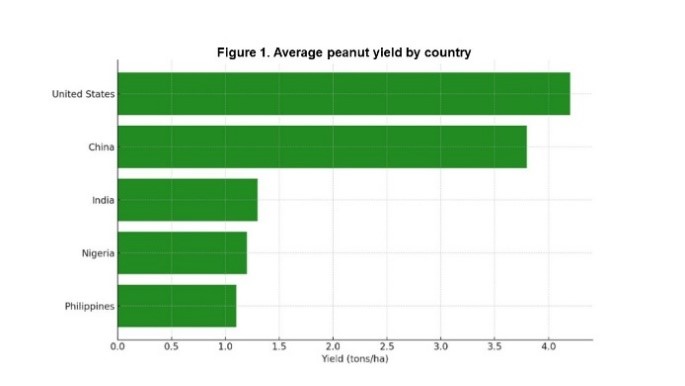Peanut Production in Central Luzon, Philippines: An Assessment of Farmer Practices, Challenges, and Profitability
Abstract
Peanut is a crucial leguminous crop grown by farmers in Central Luzon, acknowledged for its economic and ecological significance. Peanuts function as a versatile rotation crop, thriving in warm regions with well-drained, sandy or loamy soils, and significantly contribute to sustainable farming methods by enhancing soil fertility. Central Luzon, recognized as a key peanut-producing area in the Philippines, significantly contributes to fulfilling the demand for this crop. Nonetheless, numerous challenges remain, obstructing the growth and productivity of the industry. Farmers in the region encounter challenges including restricted access to premium seeds, dependence on conventional farming techniques, and vulnerability to pests and diseases. Due to insufficient support for training, extension services, and research funding, the identified challenges result in decreased yields and variable production quality. Mechanization, especially in the context of labor-intensive harvesting, is still not fully developed, resulting in smallholder farmers relying on inefficient and time-consuming methods.
This paper presents a thorough evaluation of peanut production in Central Luzon, including an analysis of farms and farmers, an assessment of production costs and returns, identification of constraints, proposed interventions, and a review of current research and development initiatives. Notable challenges encompass restricted access to high-quality seeds, inadequate training and extension support, and a deficiency in mechanized post-harvest equipment. The demanding processes of planting, weeding, and harvesting significantly constrain the growth of peanut production areas and overall yields. To effectively address these gaps, it is essential to foster collaboration among stakeholders. This includes the development of suitable machinery for small farm holdings, the implementation of training programs, and the enhancement of investment in peanut research and extension.
References
Billen, G., Lassaletta, L., & Garnier, J. (2015). A vast range of opportunities for feeding the world in 2050: Trade-off between diet, N contamination and international trade. Environmental Research Letters, 10(2), 025001. https://doi.org/10.1088/1748-9326/10/2/025001
Department of Agriculture-Bureau of Plant Industry. (n.d.). The peanut plant description. http://bpi.da.gov.ph/bpi/images/Production_guide/pdf/PEANUT.pdf
Department of Agriculture-Regional Field Unit 6. (n.d.). Agribusiness-Peanut. http://rfu6.da.gov.ph/agribiz/peanut.htm
Donayre, D. K. M., Santiago, S. E., Martin, E. C., Lee, J. T., Corales, R. G., Janiya, J. D., & Kumar, V. (2019). Weeds of vegetables and other cash crops in the Philippines. Philippine Rice Research Institute. https://www.pinoyrice.com/wp-content/uploads/weeds-of-vegetables-and-other-cash-crops-in-the-philippines.pdf
Food and Agriculture Organization of the United Nations. (2023). FAOSTAT: Crops and livestock products. https://www.fao.org/faostat
Gatan, M. G. (2015). Growth and yield performance of peanut (Arachis hypogaea) lines in Pampanga, Philippines. JPAIR Multidisciplinary Research, 20(1), 68–82. https://doi.org/10.7719/jpair.v20i1.314
Gordon, A. (2022, March 14). Yield losses due to pests. AGRIVI Farm Management. https://www.agrivi.com/blog/yield-losses-due-to-pests/
Huelgas, R. R., Manuel, P. C., & Gabriel, E. S. (1990). Socioeconomic study on peanut production in the Philippines (Book Series No. 90/1990). Philippine Council for Agriculture, Forestry and Natural Resources Research and Development, Department of Science and Technology.
Moreno, L., Santos, A. F., Tubbs, R. S., Grey, T. L., Monfort, W. S., Lamb, M. C., & Pilon, C. (2023). Physiological components of seed quality in runner-type peanut during seed formation. Agronomy Journal, 115(6), 2859–2872. https://doi.org/10.1002/agj2.21506
Philippine Rice Research Institute. (2016). Farm size and ownership. Ricelytics. https://www.philrice.gov.ph/ricelytics/farmdetails
Philippine Rice Research Institute. (2016). Household size and source of income. Ricelytics. https://www.philrice.gov.ph/ricelytics/hhsizeincome
Philippine Statistics Authority. (2021). Agricultural indicators system: Employment and wages in agriculture. https://www.psa.gov.ph/system/files/main-publication/AIS%20Employment%20and%20Wages%202017-2021%20%28signed%29.pdf
Philippine Statistics Authority. (2022, March 23). Household population, number of households, and average household size of the Philippines (2020 Census of Population and Housing). https://psa.gov.ph/content/household-population-number-households-and-average-household-size-philippines-2020-census
Ramos, R. A. (2020). Peanut (Arachis hypogaea) production as influenced by various row and hill spacings. International Journal of Innovative Science and Research Technology, 5(8), 639–645.
Saese, H., Fahey, G., & Bafui, J. (2006). Evaluation of peanut (Arachis hypogaea L.) varieties in the Lower Markham Valley of Papua New Guinea. In Improving yield and economic viability of peanut production in Papua New Guinea and Australia (pp. 1–7).
United States Department of Agriculture, Foreign Agricultural Service. (2023). Oilseeds: World markets and trade – Peanuts section. https://www.fas.usda.gov
University of Florida. (n.d.). Conservation tillage peanut production (EDIS Publication No. AG187). University of Florida, Institute of Food and Agricultural Sciences Extension. http://edis.ifas.ufl.edu/pdffiles/AG/AG18700.pdf
Weed Science Society of America. (2019, July 3). Researchers calculate yield loss from weeds. https://www.farmprogress.com/weeds/researchers-calculate-yield-loss-from-weeds
Whitty, E. B. (2002). Producing quality peanut seeds. University of Florida, Institute of Food and Agricultural Sciences Extension.


This work is licensed under a Creative Commons Attribution 4.0 International License.
Copyright for this article is retained by the author(s), with first publication rights granted to the journal.
This is an open-access article distributed under the terms and conditions of the Creative Commons Attribution license (http://creativecommons.org/licenses/by/4.0/).
























